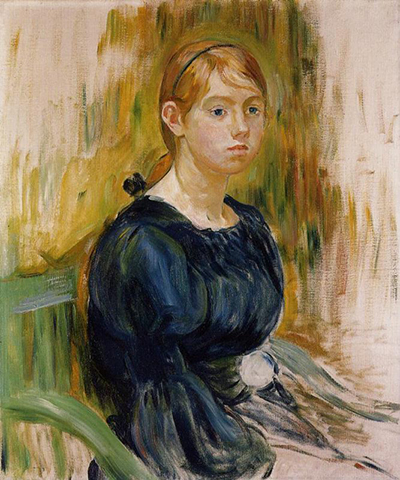This portrait of Jeannie Gobillard is dated at 1894 and now resides within a private collection. It appears to be a study painting, where only a few layers of oil are used, meaning much of the canvas shows through.
The subject looks to be in a thoughtful mood as she stares off into the distance, just to our right. Jeannie has carefully styled auburn hair with a thin black headband which keeps everything in place for the painting. Morisot is known to have asked subjects to sit several times for a single painting as she would change her mind many times over. The artist just focuses on the key parts of the composition in this painting, leaving all the rest pretty unfinished. It may have been that she intended to re-visit the piece later to finish it off, or perhaps she abandoned the project entirely for one reason or another. She therefore completes the upper body of the model, featuring a dark blue dress with some small bands around her waist. She also seems to be sat on a green chair, perhaps a garden or park bench. The tones of colour behind her might suggest an overhanging tree or other foliage.
Morisot regularly captured portraits within outdoor settings such as this, and found family gardens easier to work with, as fewer disturbances were likely to occur. Her portraiture tended to focus on the lives of young women, with older women and men used less frequently. This gave her oeuvre an important variation from other Impressionists, and this pricked the interest of the public who became interested in her work, as well as Mary Cassatt who worked in a broadly similar manner. Whilst this portrait of Jeannie Gobillard may have been unfinished, this can be viewed as a positive in one way because of how it allows us to learn more about the techniques used by the artist as she put paintings together. Normally, most stages of production are disguised by layers of oil that are applied afterwards, but in this case we see many of these elements of preparation as they are left exposed.
Paule Gobillard was the sister of Jeannie and she herself would become a painter. The family were well known to both the Morisot and Manet families, and so it became encouraged to pursue art as a career, even for the women. This provided a support network which was needed at a time when society would not always encourage female artists. Both of these sisters would model for others too, and so they exchanged ideas and opinions whilst in the company of these different families. There were several photographs taken of the family in the home, which helps us to learn more about the different siblings. One of these photographs was even taken by famous painter, Pierre-Auguste Renoir and that now resides within the permanent collection of the Met in the US.




